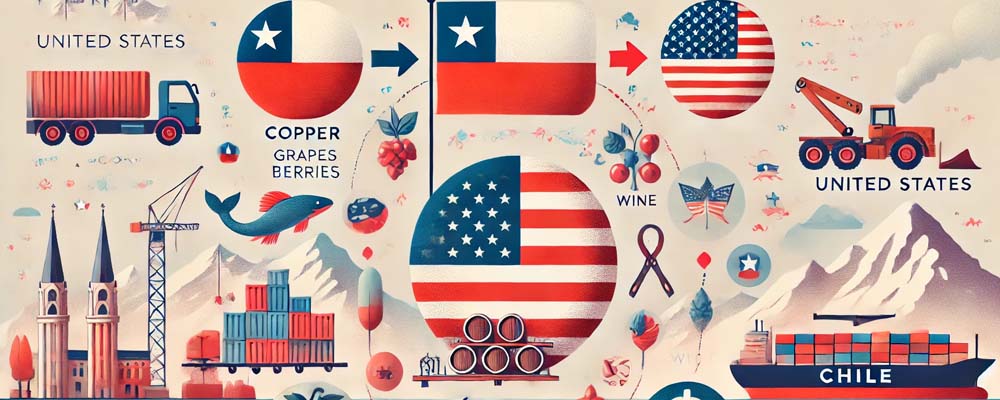
Chile, a South American economic leader, has developed a globally integrated economy due to its natural resources, strategic location, and trade-focused policies. As a key player in global trade, it is crucial for freight forwarders, logistics providers, importers, exporters, and related businesses to understand Chile’s trading relationships in order to identify potential opportunities and challenges. In this blog, we will delve into Chile’s top trading partners, while also highlighting the countries and industries that shape its export and import landscape.
Overview of Chile’s Trade Landscape
Chile’s economy, which heavily depends on international trade, sees exports and imports contributing significantly to more than half of its Gross Domestic Product (GDP). With a population of 19 million, the nation has gradually transformed into one of the world’s most open economies. This openness is further bolstered by trade agreements with over 60 countries. Consequently, these agreements enable Chile to engage in a wide array of trade activities and access global markets with fewer barriers.
By 2023, Chile’s total trade surpassed $150 billion. As a result of this, the country’s strong reliance on exports, particularly from sectors such as mining, agriculture, and forestry, has positioned Chile among the largest economies in Latin America. Simultaneously, the country imports critical goods such as machinery, vehicles, and fuels to meet domestic and industrial demands.
Chile’s free trade agreements (FTAs) and economic partnerships have fostered strong relationships with countries in Asia, Europe, and the Americas. The following sections highlight Chile’s key trading partners for exports and imports, offering insights into the global markets driving its economy.
Top Trading Partners of Chile: Exports
1. China
China is Chile’s largest export market, accounting for over 35% of the country’s total exports. The economic partnership between the two nations has flourished due to China’s insatiable demand for copper, which is essential for its construction and electronics industries. Chile is the world’s largest copper producer, and its mineral exports fuel the rapidly expanding Chinese economy.
In addition to copper, Chile exports other natural resources such as fruits, seafood, and wood products to China. China’s growing middle class has increased demand for premium Chilean products, such as wine and fresh produce.
 2. United States
2. United States
The United States is Chile’s second-largest export market, accounting for about 13% of total exports. Moreover, this trade relationship is further supported by the U.S.-Chile Free Trade Agreement, which, in turn, has lowered tariffs on many Chilean products, thereby making them more competitive in the U.S. market. Chile exports copper, fresh fruits (such as grapes and berries), seafood, wine, and wood products to the U.S.
Chile’s agricultural sector benefits greatly from this relationship, particularly during the Northern Hemisphere’s winter months when U.S. demand for fresh produce is high.
3. Japan
Japan ranks as Chile’s third-largest export market, representing approximately 10% of total exports. Like China, Japan relies heavily on Chilean copper to fuel its electronics, automotive, and construction industries. In addition, Japan is a key consumer of Chilean seafood, fruits, and wood products.
Japan and Chile have a longstanding trade relationship strengthened by the Economic Partnership Agreement (EPA) signed in 2007, which has helped both countries expand their trade volumes.
4. South Korea
South Korea is another significant trading partner for Chile, importing a variety of goods, including copper, seafood, and fruits. Chile’s Free Trade Agreement with South Korea, signed in 2004, was the first FTA between an Asian and a Latin American country. Since then, trade volumes have increased substantially.
Chile’s wine industry has also made inroads into the South Korean market, benefiting from growing consumer interest in premium beverages.
5. Brazil
Brazil is Chile’s largest trading partner in South America, making it a key destination for Chilean exports like copper, chemicals, fruits, and wood products. Their strong trade relationship is supported by regional agreements such as the Pacific Alliance and Mercosur. With Chile supplying raw materials and Brazil offering manufactured goods, their complementary economies foster regional economic integration.
Top Trading Partners of Chile: Imports
 1. China
1. China
China is not only Chile’s largest export market but also its biggest source of imports, contributing over 25% of Chile’s total imports. The country imports a wide range of Chinese goods, including electronics, machinery, textiles, and consumer goods. China is also a major supplier of construction and mining equipment, critical to Chile’s infrastructure and mining industries.
As Chinese goods are often competitively priced, they dominate Chile’s retail and industrial sectors, making China an essential trading partner for Chile’s imports.
2. United States
The United States is Chile’s second-largest source of imports, supplying approximately 15% of Chile’s total imports. American goods include machinery, vehicles, chemicals, and pharmaceuticals. Chile’s healthcare and pharmaceutical industries rely on high-quality products imported from the U.S.
The U.S.-Chile Free Trade Agreement continues to play a crucial role in facilitating smooth trade flows between the two countries by reducing tariffs on many goods.
3. Brazil
Brazil is a key supplier of goods to Chile, particularly in the automotive, chemical, and agricultural sectors. Chile imports significant food products, machinery, and vehicles from Brazil, vital to its domestic economy. Their geographic proximity and regional trade agreements make Brazil a key import partner.
4. Argentina
Argentina is a crucial supplier of energy to Chile, particularly natural gas and crude oil. Argentina also exports agricultural products and machinery to Chile. As neighboring countries, Argentina and Chile benefit from well-established trade routes and regional agreements that facilitate cross-border commerce.
Given Chile’s reliance on Argentina for energy supplies, trade between the two countries is expected to grow in the coming years.
5. Germany
Germany is one of Chile’s key European trading partners, supplying machinery, vehicles, and chemical products. German-made industrial equipment is in high demand, particularly in Chile’s mining and manufacturing sectors, where reliability and efficiency are crucial.
Germany’s reputation for producing high-quality goods makes it a valuable supplier for Chile’s industrial needs, driving a steady flow of imports from Europe.
 Conclusion
Conclusion
Chile’s global trade network is crucial to its economic growth. Understanding its top trading partners and sectors is key for businesses in logistics, importing, and exporting to navigate the market. With strong ties to China, the U.S., Japan, and Brazil, Chile offers opportunities for regional and global expansion. As it deepens trade agreements and diversifies exports, Chile remains a vital player in global commerce, presenting significant opportunities for logistics providers, customs brokers, and exporters.




 2. United States
2. United States 1. China
1. China Conclusion
Conclusion



